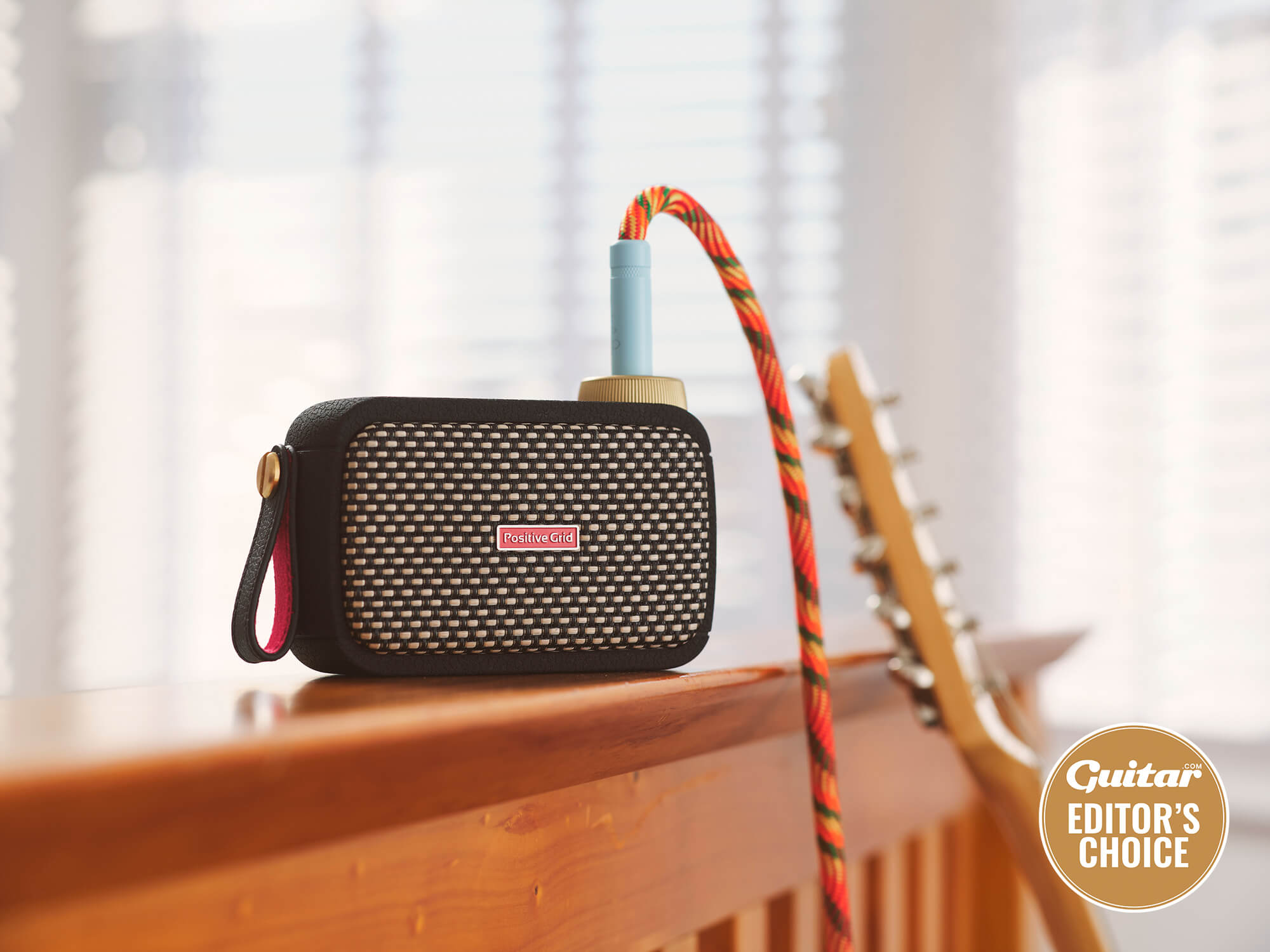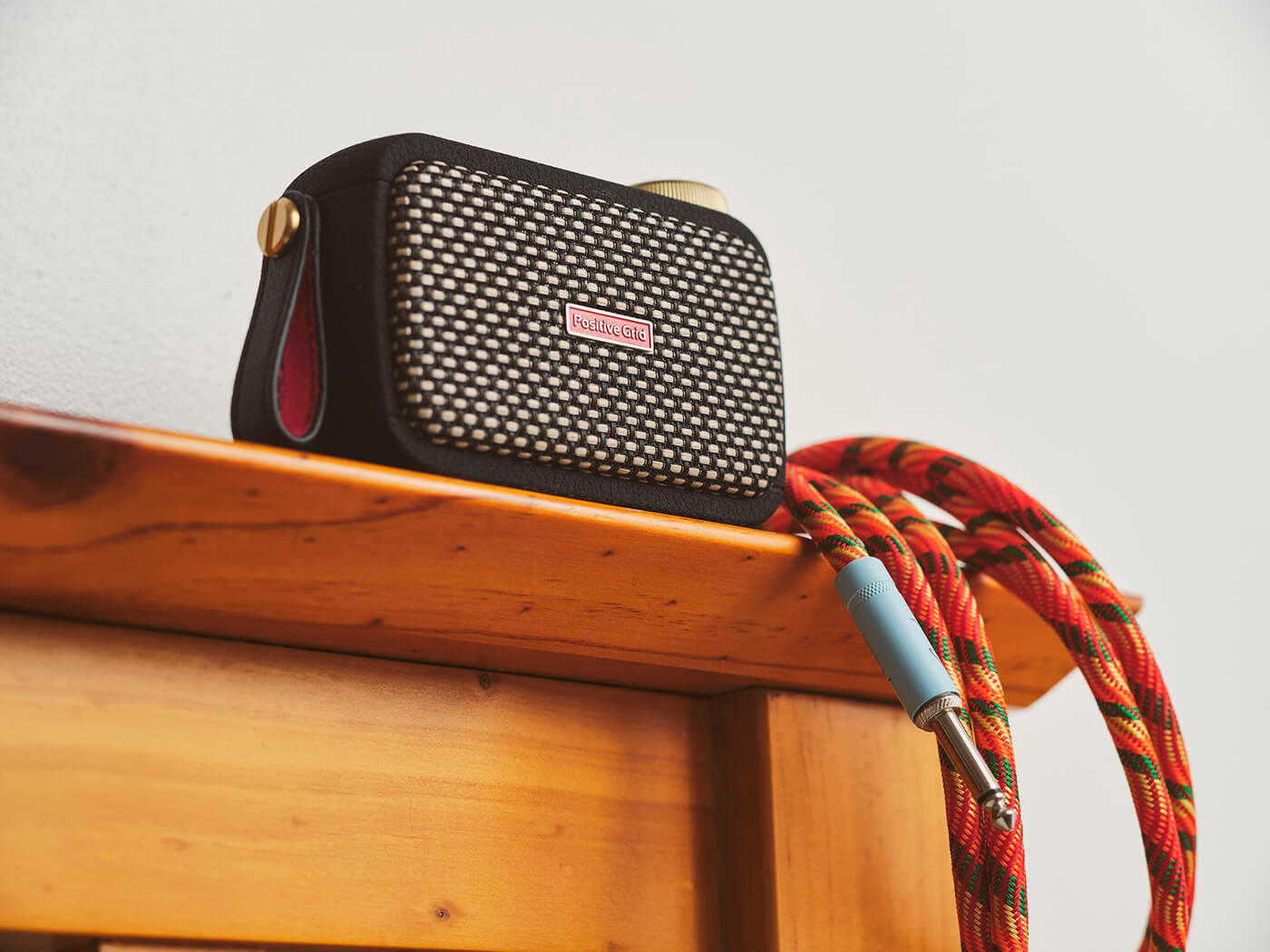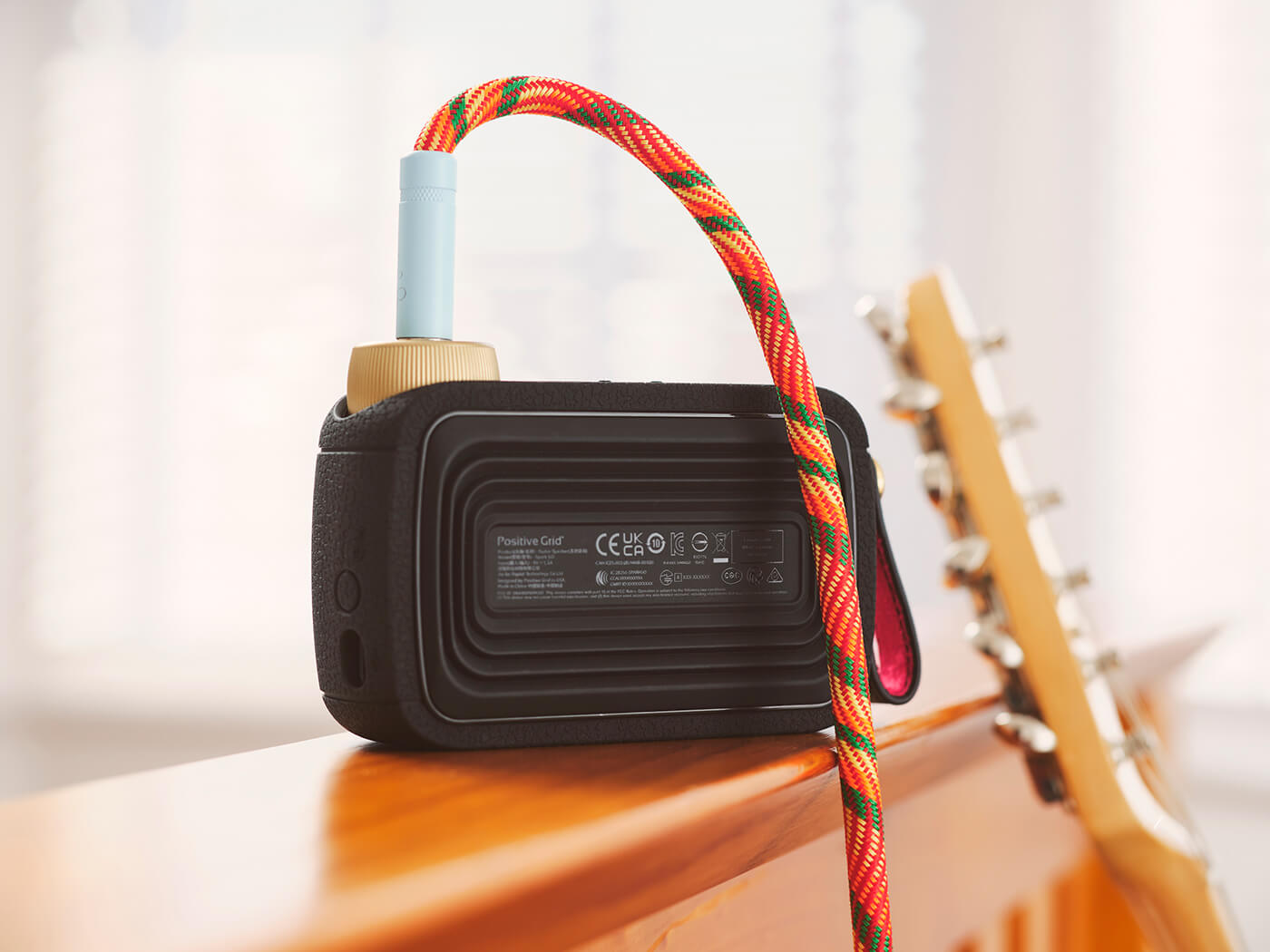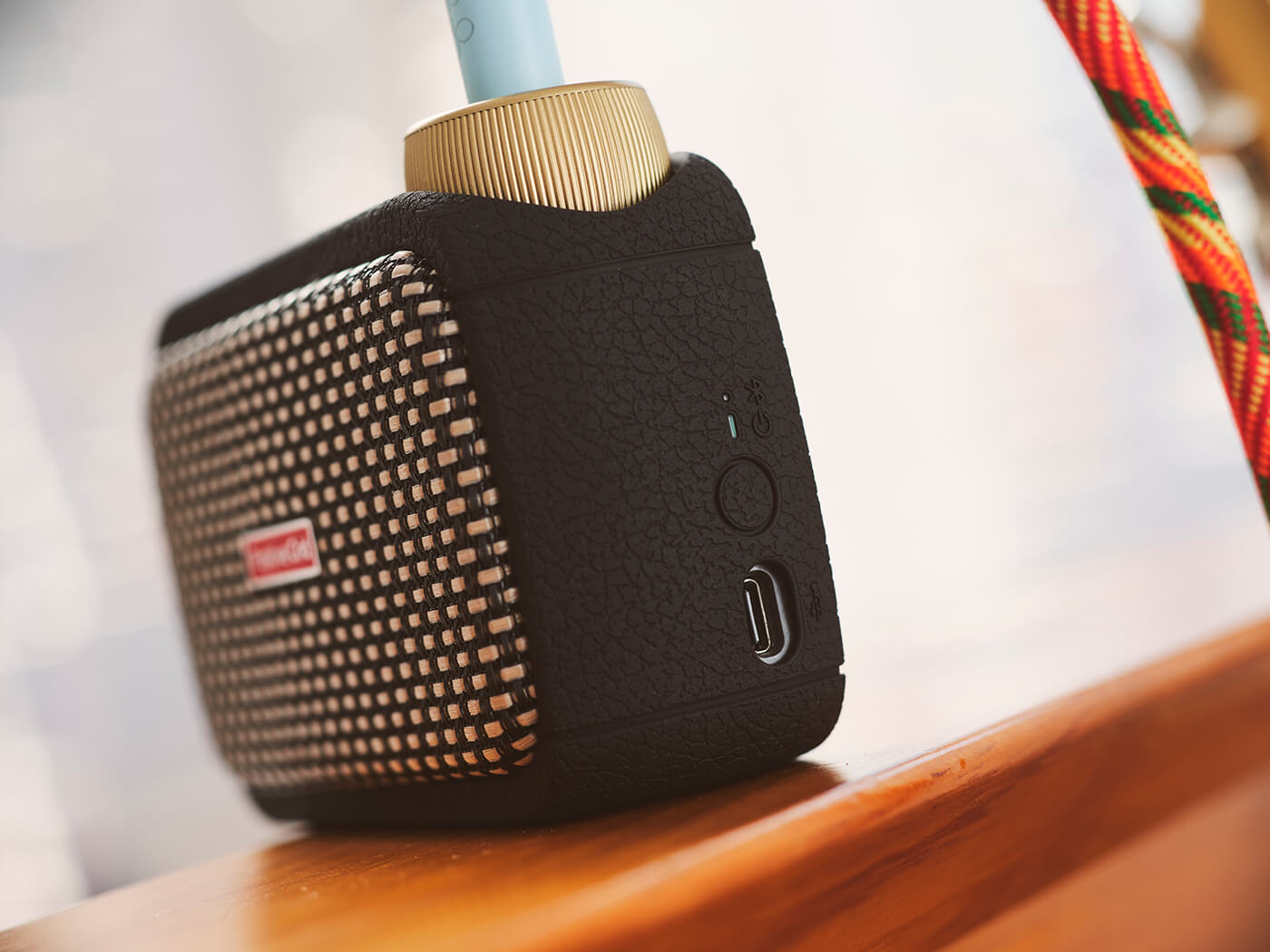Related Tags
The Big Review: Positive Grid Spark GO – the portable amp finally goes big
Positive Grid has found a way to make the Spark small enough to fit in your pocket. Is this the start of the portable amp revolution?

Review Overview
Our rating
9
Our verdict
Last year, we reviewed Positive Grid’s second smart amp, the Spark Mini, and confidently told you that the milk-carton-sized box of wonder was the best practice amp that money could buy. But now it’s 2023 and there’s a new Spark on the block – and this one’s even smaller and more portable than the Mini… does that mean the Spark GO is ready to ascend the throne? Let’s find out.
But first, a refresher for those who perhaps haven’t been following the rapid rise of the Spark since it debuted just before the pandemic. The original Spark 40 was the first guitar amp product from US software amp sim specialists Positive Grid and effectively promised to be the ultimate desktop amp – a 40-watt, two-speaker lunchbox amp that also acts as a USB recording interface and Bluetooth speaker. What’s more the Spark comes with a suite of revolutionary app-enabled features that lean on PG’s amp modelling expertise to provide a huge array of onboard sounds, as well as hugely impressive practice and learning features such as the we-used-AI-before-it-was-cool SmartJam feature, which listens to your playing and creates a bespoke backing track to accompany you.
Arriving as it did shortly before every guitarist in the world became an enforced bedroom player (and just as scores of new and returning players came to the instrument) the Spark was a ‘can’t make them fast enough’ smash, seemingly finding a place on the desks or in the home studios of every guitarist on Instagram and beyond. More than just a niche hardware product experiment from a music technology company, the Spark was a bona fide phenomenon.

Fast-forward a couple of years and the Mini – a Spark that was effectively a third of the size of the original, battery-powered and portable, yet still sporting all of the functionality and great sound of the original – redefined what we believed that a portable practice amp was capable of, so what of 2023’s new darling, the GO?
Well, first we need to talk about the size – we thought the Mini was small, but this is so small it feels like it’s showing off. It’s roughly the size of a compact stompbox, or a couple of packs of cigarettes stacked on top of each other if you prefer, and yet somehow it’s a genuine, bona fide guitar amp.
Getting it out of the box, the first thing you notice is the weight – at just under a pound it strikes a nice balance between ‘reassuringly weighty’ while not being something you are gonna get a sore shoulder from if you have it stashed in a rucksack all day. Holding it in your hand, it feels different to the previous Sparks, too – gone is the classic Tolex covering, replaced with a textured rubber sleeve over the plastic shell. It’s not the most premium experience in the world, but it’s also reassuring – the rubber gives it a grippiness when you have it resting on a hard surface, and it also gives the vibe that you won’t need to panic to much if you drop it, or worry about it getting damaged carrying it around in your back or pocket.

The Mini managed to squeeze everything into itself by making some compromises in terms of control layout and connectivity compared to the 40-watt version, and we expected a similar stripping back to make things work here, but remarkably that’s not really the case. Just like the Mini we have separate controls for guitar and bluetooth audio volume, plus the ability to select from four hardware signal chain presets, a headphone out, guitar input, plus USB-C output for recording.
The only thing missing from the Mini is a 3.5mm aux input, and who’s still streaming music like that really? Other than that, the only compromises, if you can call them that, are that you have a single button to switch between the four presets as opposed to a rotary knob, and the power/bluetooth pairing is now controlled by a single button. Perhaps the cleverest and most obvious bit of industrial design on the GO is the guitar volume knob, which also doubles as the cup of the input jack – on a unit where the controls are generally pretty small and a little fiddly, having a big gold knob to determine the most important thing has to be a good thing.
Another thing the GO offers is out-of-the-box customisation. Both previous Sparks have detachable speaker grilles that you can replace with a personalised design ordered direct from Positive Grid. While there’s no option to do this for the GO (yet) we are pleasantly surprised to find that it comes with some customisation options in the box – in addition to the default gold and black basketweave grille and red/black reversible leather carry handle you also get a second hard black plastic grille with herringbone pattern, and a rubber handle made of the same material as the amp is coated in. It’s a little thing, but a nice way for PG to empower users to make the GO feel more like theirs out of the box.
It’s also worth noting that the rubber sleeve of the amp is easily removable – given that all previous Sparks have come with different colour options down the line, we wouldn’t bet against Positive Grid coming out with some phone case-esque swappable sleeves in different patterns and colours down the line.

In Use
The first thing you’ll need to decide upon plugging in your guitar is how you’re going to use it – the GO has tiny rubber feet that seemingly encourages you to use it stood up like a traditional amp, but not so fast. Like the Spark Mini, the GO has a ‘passive radiator’ speaker on the back designed to accentuate the bass frequencies. In practice, we find that using it with the passive radiator flat onto a table or desk improves the bass response of the GO, giving it a more rounded and room-filling sound than when it’s upright. Laying it flat also prevents you from tipping the thing over with an inopportune yank on your guitar’s lead, while the passive radiator also provides a fairly substantial gripping surface for tabletop use, which is reassuring even given the rugged vibe of the GO – it’s probably better to not bounce any electronic device off the floor on the reg if you can help it.
Of course, if you want to avoid all of this faff there is a third way – you could simply hook the GO’s carry strap to your guitar strap or belt, connect them using a short patch lead, et voila – you have possibly the most portable and easy-to-use amp and guitar combo imaginable.
The GO is rated at just five watts and using it in this configuration does have its drawbacks from a volume perspective – with the speakers pointing away from you and without anything hard to resonate with (unless you happen to be jamming in a suit of fine plate armour) it can be pretty hard to hear yourself, even with the volume whacked up fully.
While this is definitely improved by pointing the amp in your general direction, we do find ourselves regularly hearing the ‘cuh-chunk’ string mute noise that signals you’ve got the guitar volume up to maximum when using some of the cleaner and more low-output signal chains. It’s still plenty loud enough to enable its likely primary use as a bedroom practice tool, but if you’re struggling to be heard in a noisy environment, might we recommend headphones? Yes we know, for many guitarists using headphones to play guitar is a complete anathema, but the GO is one of the most impressive headphone amps we’ve encountered – and a real step up on the Mini. With plenty of volume and a directness of sound that makes you feel less like you’re listening on cans and more like you’re standing in front of an amp, it’s a very viable option – even if you usually wouldn’t countenance such a thing. And with up to eight hours battery life from a full charge, you’ve got the freedom to take it out and about.

We’ve spent a lot of time talking about the user experience and not much talking about the actual sounds, but that’s because if you’ve read a review of a Spark before, you already know what we’re gonna say. The GO uses the same app as the other Sparks, and so you get the same bevvy of amps and effects previously, and once again they sound great – whether it’s modelling a crystalline Two-Rock or a monstrous Diezel, it’s hard to believe that it’s all coming out of this tiny little amp. Inevitably perhaps, the bass response is a little lacking in girth with some of the heavier settings, but it’s still hugely impressive for something that’s barely the size of a Boss DS-1.
As with previous Sparks, the GO gives you access to all the smart learning and jamming tools that its larger siblings did, but how much you engage with the Spark app is up to you. Some of us will just want to select four signal chains that we like (either from the PG-made presets, one created yourself or one of the hundred of user-generated options downloadable from the cloud), save them to the amp and never open it again – but there’s so much fun to be had within the app, we’d recommend at least giving it a try first.
Positive Grid says that the battery is good for eight hours of use on a full charge, and while it might not have quite got there on our tests, it was more than enough to enable many hours of playing, listening to music and recording.
The temptation with the GO is to ask, ‘Well how small is next year’s model going to be?!’ and maybe Positive Grid will surprise us again down the line with something even more compact and remarkable. But that shouldn’t detract from what a remarkable achievement the Spark GO is – a truly go-anywhere amp for electric guitarists that feels as rugged and durable as any bluetooth speaker, with a sound fit for an amp 10 times its size. For the price, if you don’t already have one of these in your gigbag, what are you waiting for?
Key Features
- PRICE: £129/$149
- DESCRIPTION: Digital modelling amp with smartphone companion app
- POWER RATING: 5 watts
- CONTROL PANEL: 1x guitar input, Preset switch, Guitar volume, Music volume, 3.5mm headphone out
- SIDE PANEL: USB-C charging/recording out, power/Bluetooth pairing switch
- SPEAKERS: 1x 2” active stereo speakers with passive radiator
- DIMENSIONS: 125 x 85 x 45 mm
- WEIGHT: 0.35kg/0.76lb
- CONTACT: Positive Grid
Like This? Try These
- Fender Mustang Micro £109
- Blackstar Fly 3 £69
- Boss Waza Air £349
